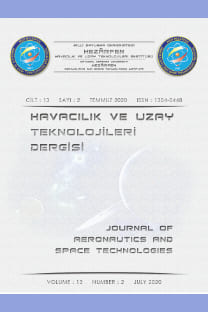Hibrit Manevra Tabanlı Yapı ve Güvenlik Stratejisi Yaklaşımı ile 2x1 Hava Muharebelerinin Değerlendirilmesi
Evaluation of Two-vs-One Air Combats Using Hybrid Maneuver-Based Framework and Security Strategy Approach
___
- [1] Austin, F., Carbone, G., Falco, M., Hinz, H., and Lewis, M., “Automated maneuvering decisions for air-toair combat”, In Guidance, Navigation and Control Conference, page 2393, 1987.
- [2] Austin, F., Carbone, G., Hinz, H., Lewis, M., and Falco, M., “Game theory for automated maneuvering during air-to-air combat”, Journal of Guidance, Control, and Dynamics, 13(6):1143–1149, 1990.
- [3] Başar, T., and Olsder, G. J., “Dynamic noncooperative game theory”, SIAM, 1998.
- [4] Baspinar, B., and Koyuncu, E., “Aerial combat simulation environment for one-on-one engagement”, In 2018 AIAA Modeling and Simulation Technologies Conference, page 0432, 2018.
- [5] Burgin, G. H. , and Sidor, L., “Rule-based air combat simulation”, Tech. Report, TITAN SYSTEMS INC LA JOLLA CA, 1988.
- [6] Ferguson, T. S. , “Game theory”, 2014.
- [7] Lygeros, J., Tomlin, C., and Sastry, S., “Hybrid systems: modeling, analysis and control”, preprint, 1999. [8] McGrew, J. S., “Real-time maneuvering decisions for autonomous air combat”, PhD thesis, Massachusetts Institute of Technology, 2008.
- [9] Mitchell, I. M., and Tomlin, C. J., “Overapproximating reachable sets by hamilton-jacobi projections”, Journal of Scientific Computing, 19(1):323–346, 2003.
- [10] Nguyen, L. T., Ogburn, M. E., Gilbert, W. P., Kibler, K. S., Brown, P. W., and Deal, P. L., “Simulator study of stall/post-stall characteristics of a fighter airplane with relaxed longitudinal static stability”, 1979.
- [11] Raskin, J. F., “An introduction to hybrid automata”, In Handbook of networked and embedded control systems, pages 491–517, Springer, 2005.
- [12] Shaw, R. L., “Fighter Combat”, Naval Institute Press, 1985.
- [13] Sheffield, R. G., “The Official F-15 Strike Eagle Handbook”, Compute Pu, 1990.
- [14] Stevens, B. L., Lewis, F. L., and Johnson, E. N., “Aircraft control and simulation: dynamics, controls design, and autonomous systems”, John Wiley & Sons, 2015.
- [15] Virtanen, K., Karelahti, J., and Raivio, T., “Modeling air combat by a moving horizon influence diagram game”, Journal of Guidance, Control, and Dynamics, 29(5):1080–1091, 2006.
- ISSN: 1304-0448
- Yayın Aralığı: 1
- Başlangıç: 2003
- Yayıncı: Dr. Öğr. Üyesi Fatma Kutlu Gündoğdu
Geliştirilmiş Zigzag Teorisi Kullanarak Fonksiyonel Kademelendirmiş Plakların Eğilme Analizleri
Seyed Alireza Jalali CHIMEH, Hassan Karimi Mazareh SHAHI, Mohammad Shafiei DEHAJ
Flexure Analysis of Functionally Graded Plates Using {2,2}-Refined Zigzag Theory
Synthesis and Characterization of Epoxy/Boron Nitride Composite for Aerospace Applications
An Optimization Approach for the Daily Photograph Selection of Earth Observation Satellites
Yer Gözlem Uydularının Günlük Fotoğraf Seçimi İçin Optimizasyon Yaklaşımı
Havacılık Uygulamaları için Epoksi/Bor Nitrür Kompozitinin Sentezi ve Karakterizasyonu
